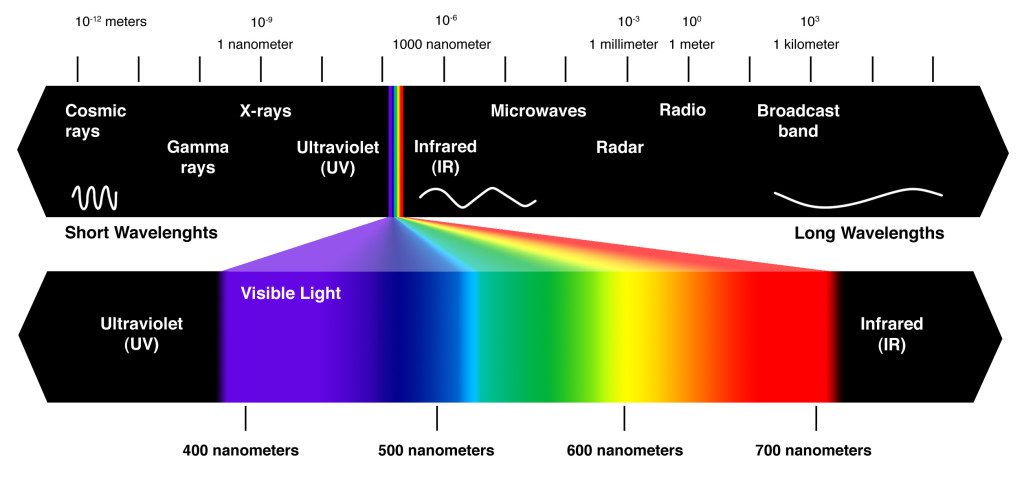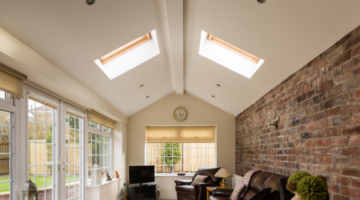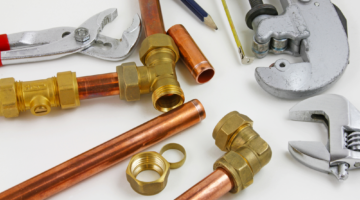
What is infrared light?
Infrared light is the reason why we feel warm when the sun is shining in the middle of a wintery day. Conventional wisdom would suggest that if the air temperature were freezing, then you too would feel cold. However the infrared waves emitted by the sun travel unimpeded through space, and warm any object they hit, including your body.
Infrared is a form of electromagnetic radiation that sits just beyond the red end of the visible light range of the electromagnetic spectrum. We often hear the word radiation and automatically associate it with being harmful, but in fact, radiation is just a process of energy emission. Just like visible light radiation, infrared radiation is 100% safe and even our own bodies emit infrared radiation (which is what allows search and rescue helicopters to find lost travellers at night for example).
Conventional space heating in homes
Conventional heating in the home works by warming up the air around you; for instance a radiator does most of its heating through convection currents (it also gives off small amounts of infrared radiation).
When the radiator warms up, it heats the air directly around it, which then expands and rises. As the hot air rises, it creates a vacuum behind it, which pulls colder air into contact with the radiator, causing it to heat up. As the hot air begins to cool down it drops down back to floor level. This cold air gets heated again and this process keeps repeating itself – this is known as convection heating.
Most conventional heating systems do emit some infrared waves. For example, if you have ever sat near an open fire, you will have felt the heat on your face. Then when you put your hand in front of your face, this stops the infrared hitting your face directly; instead you will feel your hands get warm. This is infrared.
Infrared heaters in the home
Infrared heating is a fairly recent addition to the domestic and commercial heating scene. It is emitted from the heater, which then travels unimpeded through the air until it hits an object. The object absorbs the radiation, causing molecules within it to vibrate, producing heat.
If the waves come into contact with humans, they will travel about an inch into the body providing a feeling of deep heat, but even if you are not directly in the way of the waves, any solid body will vibrate when the waves hit them, causing them to radiate heat back towards you.
Despite being able to purchase gas, oil and solid fuel infrared heaters, we suggest using electric infrared panels in the home, since you do not need to integrate any pipework or fuel storage facilities when you install the panels. There are also no direct emissions associated with using the electrical panels (and if you use them in conjunction with solar panels you get 100% emission-free heating). According to a study made by Jigsaw infrared when adding solar panels to their infrared heating, you could save up to 50% on your energy bills. They also can be placed high up on the walls or the ceiling, so they will be easy to keep away from pets and children (they get about as warm as a standard radiator).
The electric panels come in numerous sizes and certain models can double up as mirrors. Since they have no moving parts, they operate in complete silence, which makes them ideal for any property.
>>> The cost of heating your home with gas vs electricity <<<
Energy savings from infrared heaters
Infrared heating works by heating the surface area of a room, rather than the volume (as is the case the traditional convection heaters), which means they are heating considerably less to provide the same amount of heat.
The following worked example compares a 800 Watt infrared heat panel and a standard 2000 Watt convection heater (like for like providing the same comfort of heat), providing heat up to 4 months of winter (November through to Feb 119 days) for 8 hours a day at a cost of £0.30 per kWh of electricity (As of May 2022 estimated 10 minutes per hour of use for IR panel. 10 minutes per hour for convection heater).
| Infrared Heater | Convection Heater | |
|---|---|---|
| Energy rating | 800 Watts | 2000 Watts |
| Electricity units per hour | 0.80 | 2.00 |
| Total electrical units used | 119kWh | 238kWh |
| Total cost | £35.70 | £71.40 |
In addition, you are heating solid walls or objects with infrared radiation and these have a thermal mass, which means they retain heat and help keep the home cosy. Conversely, air has no thermal mass, so in the case of traditional convection-warmed rooms, when a door is opened, the hot air will quickly escape; requiring you to reheat the room to feel warm again. One brilliant factor in favour of these panels is the ability to provide the home with a fully-zoned property. Unlike central heating systems, the panels can be switched on in individual rooms using the thermostats. This means that heating is only fully used when required. If you think how much energy is wasted in rooms that do not need to be heated, such as guest bedrooms, this is a real benefit.
A study was placed by Aston University and Jigsaw Infrared which found that Jigsaw’s infrared panels can increase the room temperature to 18 C in 10 mins which is less than a 2000 W storage and convection heater take 15 and 17 min respectively. Moreover, the IR heating system has an efficiency 2 times higher than a 2000 W and storage and convection heating system. Therefore, the IR panel used half the energy (50% less) of the storage heater and reached room temp in almost half the time. Therefore, Infrared heating is much more efficient at heating a space than conventional space heaters. The heat is also contained in the thermal mass of the room surfaces, as opposed to the heat. This means that it stays warmer for longer and draughts do not play as large a part when compared with convection heaters.
Infrared vs. other heating systems
| Heating System | Annual Cost |
|---|---|
| Gas central heating with zone controls | £608 |
| Jigsaw infrared with zone controls | £804 |
| Reversible air con with zone controls | £881 |
| Air-water heat pump with zone controls | £977 |
| Biomass | £1,209 |
| Electric convector heating with zone controls | £1,332 |
| Electric underfloor heating with zone controls | £1,508 |
| New electric night storage with automatic controls | £1,734 |
Based on a 2-bed property and May 2022 energy prices. Heating only.
Other advantages of infrared heating
Another major advantage of infrared heating is that unlike conventional heaters that just heat the air, infrared heaters heat the walls, which will mean they stay completely dry. It then builds up the thermal mass within the walls and the floors, which maintains the warmth and keeps it dry by reducing condensation. Therefore infrared heating helps prevent the spread of mould in the property.
>>> Get Rid of Black Spot Mould <<<
In addition, conventional heaters warm the room by convection currents that circulate dust particles continuously around the home, however these convection currents do not occur with infrared heating, so for people who suffer from asthma, infrared panels can be the ideal solution.
Benefits
- The units are compact and can be designed to provide other functions such as a mirror in the bathroom, which helps save room.
- Since infrared heaters heat solid objects in the home like walls, they prevent any moisture build-up on these surfaces and so inhibit the spread of mould.
- Fit and forget technology, very little maintenance required
- These heaters are emission-free (i.e., no fuel is burnt in their operation) and if they are used in conjunction with renewable energy sources like solar PV, you are producing 100% clean heat.
- The way these heaters heat a room is more efficient than conventional convection heaters, so they are more cost-effective to run.
- Infrared heaters warm solid objects with a thermal capacity, therefore if a room is draughty or a door is opened, the solid objects retain the heat keeping the room warm.
- low weight, small size, and no need for thermal bricks.
Limitations
- They cost about twice as much as traditional convection space heaters. However the saving difference made should mean that they pay back in a little over a year, and then you will experience savings on your energy bills.
- To feel the true benefits of the heating panel, there needs to be no obstacles between you and the heating unit, which is not always easy to achieve.
Cost
- Based on a newly built two-bedroom house, hall, and a bathroom at 18℃ with Jigsaw infrared aluminium infrared panels. IR panels are required for 5 x 400W at £395 each and 4 x 800W at £595 each. Including one room thermostat for each room at £89 each and one control Hub per property at £129. Total units and parts costing £5,285.
Installing infrared heating
Are you thinking about installing infrared heating in your home? We have scoured the country for the best tradespeople, so that we can make sure we only recommend those we really trust.
If you would like us to find you a local installer to help install infrared heating in your home, just fill in the form below and we will be in touch shortly!













Infrared heating panels seem like a good idea, but would I be better off upgrading my boiler (of around 15 years) to a new one rather than installing these panels around my house?
Hi James,
The benefit of installing the panels would be that you wouldn’t have to have bulky radiators around the house. In terms of cost, the price of kitting your house out with panels more often than not, costs around the same as a new boiler. However, because new condensing boilers are 90%+ efficient and the price of gas is around 4p/kwh then we would – in your case – recommend upgrading your boiler and only use the panels to supplement the central heating system.
Always liked the heat you get from radiant heating. Keeps the air nice and breathable but maintains temperature so you never feel cold. I have a few dogs as well and not having their hairs constantly circulated through convection heating is a plus!
Will infrared heating panels be covered under the Green Deal Home Improvement Fund do you know? I have read on the Government website that it is an approved technology but can’t find out whether it is available under the Green Deal.
Hello this is Oslo calling – love the information on here, think the infrared is something that would work in my workshop. Do you know of any suppliers that deliver to Norway? Thank you very much.
Hi Jens,
Thanks for getting in touch with us. We would be happy to ship to Norway, but we would obviously have to charge for delivery. If you would like a quote, either let us know the panels you want, or send us a floorplan so we can size the panels for you.
Kind regards,
If infrared panels are position high on a wall do they have to be angled downward to get the most benefit?
No, they hang like a picture. From research I positioned mine so that they are on a wall that is at a right angle to a window. The heat comes out like sunshine through a window (radiant?) and seems to avoid having cold spots in the room.
Should i get rid of my gas boiler and put infrared in?
Infrared panels will not supply hot water so,depends whether you like to shower or bathe I guess
could I have some details and photos please?
I prefer narrow heaters and black colour
Thanking you
Patrick
How do these compare to wet system radiators fitted with TRV’s or even eTRV+? I am really keen to see if its worth exploring changing.
Thanks for your time
I presently have white meter heating which I hate, but how would costs compare? I have a small one bedroomed flat but only ever use the heater in the living room.
I presently have white meter heating. How would running costs compare?
I am thinking of replacing my old storage heaters. Do you think these infrared heating panels are a good option? How do you control the temperature?
Hi, we do a product called heat-in-a-sheet, we use infrared heating panels and place them behind a stretched ceiling, you can then heat your entire room from above, much more efficient way of heating, cheaper to, no maintainance no servicing just install and forget, we provide a thermostat in every room to control your home exactly how you want to.
Hi Laura, we are seeing more and more people switch from storage heaters to infrared and it is proving to be a very popular, stylish and efficient alternative. They can be controlled through a thermostat, which is great.
Hi James,
The price of gas is cheaper than the price of electricity, so in theory you would be better off having a boiler. However two things to consider – firstly your boiler is old, therefore it will not be that efficient. Also with infrared you can heat just individual rooms, therefore they are more effective for space heating in some circumstances.
Have a panel as the primary heater in my living room with a stove providing the secondary heat on really cold days. Think the panel is slightly undersized though, I was told 45W/m2 but should have gone 60 I think.
I am in the process of buying a small house, with two dimple storage heaters and three electric convector heaters in tiny kitchen, tiny bathroom and tiny 2nd bedroom. 1. Would this type of heater heat a tiled surface in bathroom as well as the human. 2.If you timed the heater to go on an hr before you go into the bathroom, would it be nice and warm. Or don’t you use this heater like that. 3. If you put the heater 3ft up on a wall in a small space, would not your feet be cold. (tiny corner in L shaped sitting room). Many thanks. Caroline
Hi Caroline, the answer to questions 1 & 2 are both yes! Infrared panels do heat any solid object (so humans and tiles). And yes – switching it on a little early will ensure the room is warm when you come to use it. In terms of your feet being cold, it is not really an issue since the infrared comes out the panels at all angles, so you feet should be fine!
I had infrared panels installed throughout my house about 5 yrs ago but have constantly had to have the panels replaced as they keep shorting out ( apparently a manufacturing fault ) as they are chinesse ones and not german made as I believed when purchasing so I would say watch what you are being sold and maybe make sure they are manufactured in Germany …
We need heating in our warehouse type arts venue. Would these panels be OK installed on the ceiling?
I am from a company that has recently developed the next generation of infrared heating. We are a stretch ceiling company, we have teamed up with a radiant heating (infrared) heating company. The results are a product called heat-in-a-sheet. We place radiant heating film behind our stretch ceilings to give efficient, economical, invisible heating.
Hi Dave. Can you provide link? I’m keen to find out more! Thanks, Ben
We had storage heaters in our home I think from the 80s. We made the change to infrared and don’t regret it! The infrared heaters look sleeker and use less energy. Also can move off economy 7 which is great because the cheaper rate to be honest isn’t far off what you can get as a standard rate from a smaller utility company!
I’m about to buy a flat which has a 45 year old Selex Electricaire hearing system (warm air via ducts in the wall) which runs on on Economy 7. The hot water runs of a PulsaCoil hot water cylinder also running on Economy 7.
If I decided to switch over to infra red panels (which would presumably mean not using Economy 7) what are the options for hot water? I mostly need it for a shower in the morning and washing a few pans in the evening so have no need to fill a bath regularly. The shower currently installed runs of the Pulsacoil.
Most ‘electric only’ properties seem to rely on Economy 7 for heating and water, I’m curious to know how the hot water works if you move the heating to a standard rate for infrared panels.
Thanks
I purchased infrared panels last winter, as I had put up with expensive, ineffective storage heaters for too long. I was a bit anxious about the amount of heat and running costs. However, I am thrilled with them and highly recommend these panels. They are manufactured to a very high standard, throw out alot of heat and so cheap to run. They are also very easy to install and you can take them with you when you move! The guys at Greenage are very helpful and friendly too. Very highly recommended 😀
Hi, I just got the infrared panels and I would like to ask if leaving them switched on non stop can damage them. I know that they suggest switching them off when you are not at home. Reason is that our walls are wet and we need to dry them as fast as possible.
Hi Denisa, Herschel infrared heating panels have a lifespan of around 100,000 hours so you shouldn’t worry about leaving the panels on for long periods of time. We suggest switching the off when you aren’t at home due to unnecessary electrical usage.
Thank you very much for your help 🙂
do they compile with SAP 2012?
Hi Neil.
Not in the current update. We looked at the most recent consultation but it didn’t give any special consideration to infrared heating. We have responded to the consultation because we don’t think recent developments in radiant heating have been reflected in their assessment.
Hi- we are currently renting a semi detached house with both houses sharing oneoio boiler and heating system. We would like to stop using the oil heating, it is expressive and awkward having to share with our neighbors. how would the cost of your system comparerò in terms of running costs? Thanks
Hi Felicity,
Your best bet is to speak to the Ecostore who can put together a quote for the system and give you an idea on the running cost based on the wattage of the system proposed.
Best,
Alan
I have an inefficient mix of electric heaters and storage heaters- would this be a good replacement alternative?
Do you know which infrared panels can be used in wet rooms?
We are a major hardware retailer in slovenia and would like to start offering a range of infrared heating panels for our customers. Could you help put us in touch with manufacturers and distributors who would be willing to co-operate? Also have you heard of Herschel, Koenighaus & IR heaters? Are any of these brands any good?
If I bought an infrared heater or a panel as you call it, surely I would lose heat from the back of the panel – does that make them inefficient? Can I put some reflective matrial to the back of them as a diy thing to reflect the heat back?
I have been using infrared heaters for about 4 years now. Initially I didn’t see the reductions in energy bills as I was running parallel storage heaters on economy 9 tariff. Eventually, I ripped all those out and replaced them with additional Herschel Infrared heating panels, with the initial ones being a Chinese import. In addition to that I switched my energy tariff to a simple standing charge with a variable charge on the bill. Last year the electricity bill went down by about a quarter, and this year about 10% further on last year. I believe this is a result of zoning my heaters better with the Herschel IQ units. So, now I can get the room to a decent temperature before I come home from work, and they then come on and off to about 20’c. I would have them set to a lower temperature by I have a young daughter who needs the temperature to be a bit higher than just for my tolerances. Selecting the right heater was a minefield, but I just decided to do it. I can imagine the Brit public are a bit more sceptical. and maybe I wouldn’t have taken the plunge myself without seeing them work first hand when I was stationed at a base in Germany.
Hi We are in an 1800’s end terrace which obviously doesn’t have cavity walls etc. We currently have conventional radiators running off a combi boiler running on LPG (so expensive 😳) would infrared panels be a good by even with the lack of modern insulation?
Can infrared panels be installed by a qualified electrician, or is it a specialist job?
Hi Gareth,
A good local electrician will be able to fit them!
hi will these have any effects on people with heart problems like pacemakers and people with blood pressure issues?
Hi Sam, we have not seen any independent research to suggest that infrared heating panels have an effect on people with high blood pressure. Please have a look at this article for additional reading: https://www.thegreenage.co.uk/is-infrared-heating-safe/. The infrared heating panels incorporate ‘far infrared’ technology, which give off a gentle heat and not the intense heating found on halogen or near infrared heaters – therefore they will be very good for domestic consumption.
I had infrared heating installed in my property a couple of years ago, and out of the 6 heaters I had installed 2 are properly functioning. 2 blew the fuses, 1 had the core burn the front of the panel and one of them stopped working altogether. I know I was a bit gullible in buying the infrared panels on ebay at the time and I should have gone with a reputable retailers, BUT are all the manufacturers pretty much the same with these heaters OR did I just miss the boat at the time and should have gone with a reputable name?
I am considering purchasing an infrared heater to replace the ancient storage radiator in one of my rooms that has no gas to it. The storage radiator is floor mounted. If I put the heater where the storage radiator is (to save having to replaster the wall) will it lose inefficiency compared with having it mounted higher up?
If I install infrared heater throughout my house, is there any way I can get instant hot water (as from a combi) without a storage tank, for sinks and showers etc
Hi John,
Infrared panels are just for heating and are separate from any hot water system. There are electric boilers out there, and some infrared boilers, but these would be separate systems.
Many thanks,
Harriet
We had infrared radiators installed about a week ago. Since then, I have been suffering headaches when working in my study close to the radiator. The room is too small to move away from it (they are all installed on the ceilings) but I’m not suffering in the same way in other rooms. Have we made a huge mistake and are they a serious health risk?
i think you are dehydrated! Drink more water and you should notice the difference
Switch it off and use a convection heater (fan heater or oil radiator) on alternate days. Wont cost you too much if it’s a small room. If the headaches match closely to the heat source, then you have you answer. If it’s only a problem in one room, then investigate whether you have a faulty unit.
Hi Edward,
Infrared has actually been shown to reduce headaches, so I’m not quite sure what’s going on! It’s a very safe technology. The ‘radiation’ refers only to the manner in which the heat is transferred.
Hope you find the culprit soon!
Many thanks,
Harriet
I am trying to get someone to contact me about installing infrared throughout my home – a survey would need to be conducted but your on line firm is not working – could you contact me please?
I ripped out the storage heaters of my 2-bed flat in the summer and installed 2 infrared panel heaters in the bedroom and dining room. Thanks goodness I kept the old style heater in the lounge and the portable halogen heater. Otherwise I would be absolutely freezing this winter.
The infrared panels have proved to be neither use nor ornament. Up close you could fry an egg on them. Move a few centimetres away and you’re shivering. Absolutely useless. I now sleep with the halogen heater on to keep some of warmth in the bedroom.
As this site appears to be a cheerleader for infrared, I’m sure this comment won’t survive long.
But hopefully someone will see it and learn from my mistake. If you want to save money on your utility bills, by all means buy these infernal heaters. But be ready to shiver. My car is warmer than my home.
Hello – thanks for sharing your experience What brand of panels did you install? (I will make sure to avoid these And what wattage are they eg 600w?
I live on a greek island (yes we need heating from nov until march).Do you have an agent in Greece?
OR – if you have a map and details of my house could you make a calculation where and how many, what size I need?
Best regards, Ebba
Hi, I have a timber chalet which I use as a spare bedroom, would these heaters be a good match for an all timber building?
Hi, Is a pair of blankets this kind of limitation? ; “To feel the true benefits of the heating panel, there needs to be no obstacles between you and the heating unit, which is not always easy to achieve.”
How close to a person can they safely operate. ie. how quickly does the temperature drop off at say 1, 2 & 3 feet away, eg mounted on bathroom ceiling, say?
I am part of a team exploring how we make our church, a very large Victorian, stone built building, carbon neutral by 2030. Presently we have a gas fired water central heating system producing about 22 tonnes/pa carbon. One possibility for us to explore is using radiant heaters, and panel radiant heaters would certainly have some aesthetic advantages and may reduce the burning feeling many of us would have on our bald heads. Can you offer any guidance on this please?
Your boiler does not produce Carbon. It emits Carbon dioxide, the same stuff you breath-out!
Hi, I am about to start a conversion of an existing outbuilding into an annexe, there will not be a lot of wall space to place panels on, does anyone have any experience in ceiling mounting the panels and do they work well when mounted on the ceiling.
Thanks Simon
Steve depends how high the ceilings are. Anything over 2.7-2.8metres and you may find them working less efficiently at floor level. They should be ceiling mountable quite easily.
Hi, I have used a storage heaters to heat a second home when I am not there, Is it safe to leave infra red panels turned on when I am away for several weeks at a time? Jackie
I am building a new home and am looking at different heating options, would infra red panels work out cheaper to install than a traditional gas or oil heating system with radiators. If I used the infra red panels I assume I would still have to install something to heat the water?
I have an outside space at a school which is covered over and has pvc window walls. Would this infra red type of heating system be suitable ?
What good is a heat source high on a wall. It’s our feet we need to keep warm.
I’ve completed your form requesting an installer contacts me , but no one has
Hi how long do they stay warm when unplugged
A quote would be beneficial for my property.
I think gas boiler costs are not fully appreciated. The costs are based on the quoted efficiency of the boiler. That is only valid when the boiler runs at full power. If the boiler runs at part load, which it does most of the time, then the efficiency drops. And if a gas boiler is used solely for hot water in the summer, foe example, then the gas costs are higher than for an electric immersion heater. The boiler needs servicing. Should not annual CH breakdown cover be included in the cost?
Hi I am in the process of planning a ground floor single storey extension approximately 10m by 3m. I currently have a combi boiler and 16 radiators. I also have solar panels. I was looking at a different way to heat the extension and read your comments re heating panels.
I was also thinking of underfloor heating. I have also had a problem in the bedroom at the rear of the house as I get a lot of mould through condensation on the wall where the window is situated. Would a wall heat panel be a solution for this. Look forward to hearing from you.
Sounds good, but how do you get hot water for taps and showers? Do you still need a boiler or immersion heater?
Many of us do know that using a propane heater is not only extremely dangerous but also very expensive. You really do pay for your fuel every time you use it. One of the big questions that has been on everyone’s minds lately is, what is the safest portable heater to use?
I have a solidwall 1900 house in the UK with only 1 small outside window so get no sun heat, even with the Heating on it has cold spots, im looking to get a infrared heating panel for over the fireplace (maybe a picture print), the opposite wall is about 3.2 meters would the radiant heat get that far? Also what wattage panels do you all have?, would a 600w really be enough or better 1000w panel for a 3.5 x 4 x 4.5 room? don’t want it to warm the room on its own just to warm the opposite wall & other hard services to help with cold spots. thanks
Thanks for all the info on infrared, I’m really sold by it as a replacement for storage heaters. However I just didn’t want these ugly panels hanging off my low ceilings! I searched for about six months and found a company called Astectherm who have made infrared mats that you can plaster into your ceilings. Just wanted to share here in case anyone else wasn’t convinced by the panel suppliers calling their product ‘stylish’ .
I am considering infrared heater panels for a bathroom and hallway in a 1 bed flat (lounge/kitchen and bedroom.already have storage heaters). The bathroom will have an IR mirror panel above the wash basin but my question concerns the hallway. The hallway is 6.0m long X 0.9m wide with a door at each end of its length so a single 800W IR panel would have to be installed on a (width) wall meaning the IR panel is only 0.9m away from an opposite wall. Would an IR panel be suitable used in such a scenario or should I simply fit a couple of conventional convection electric radiators in the hallway? TIA, Mark.
I’m having difficulty seeing parts of your website on my iPhone. It’s making it impossible to see what I need. Do you have a catalogue please?